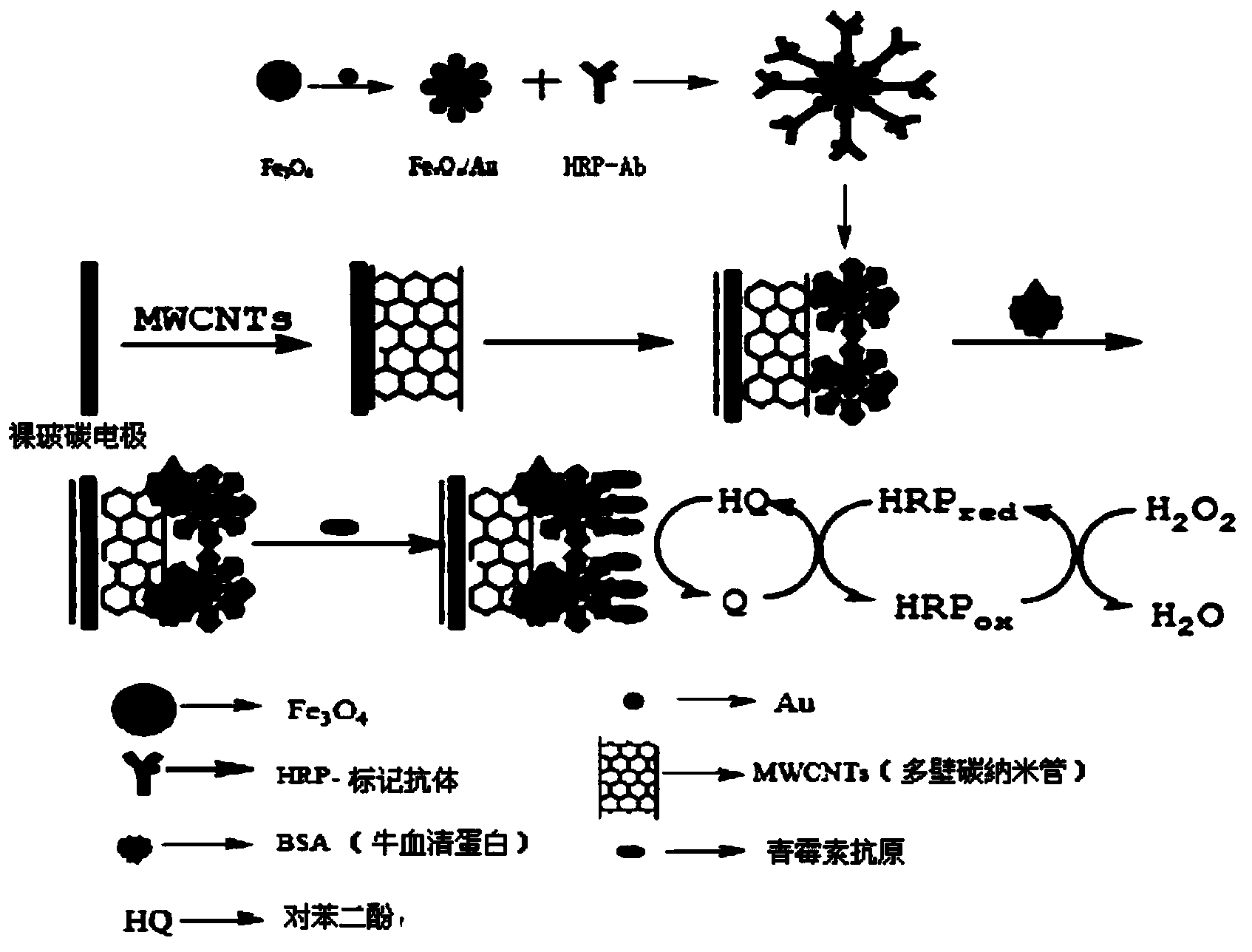Electrochemical biosensor for detecting penicillin and preparation method and application thereof
A biosensor, electrochemical technology, applied in the field of penicillin detection, can solve the problems of no disclosure, and achieve the effects of small interface resistance, enhanced catalytic efficiency, and large active area
- Summary
- Abstract
- Description
- Claims
- Application Information
AI Technical Summary
Problems solved by technology
Method used
Image
Examples
specific Embodiment 1
[0031] An electrochemical biosensor for detecting penicillin, the electrochemical sensor is a three-electrode system, including a counter electrode, a reference electrode and a working electrode, wherein the counter electrode is a platinum wire electrode, and the reference electrode is a saturated calomel electrode. The electrodes are immobilized multi-walled carbon nanotubes (MWCNTs)-Fe 3 o 4 / Glassy carbon electrode of Au magnetic nanoparticles-HRP-penicillin antibody (Pen-Ab).
specific Embodiment 2
[0032] A method for preparing an electrochemical biosensor for detecting penicillin, the principle of the electrochemical sensor detecting penicillin is as follows figure 1 As shown, the specific steps are as follows:
[0033] (1) Carboxylation of carbon nanotubes
[0034] Mix multi-walled carbon nanotubes (MWCNTs) with a mixture of sulfuric acid and nitric acid (3:1, v / v) at a mass-volume ratio of 15 mg: 20 ml, then sonicate for 7-9 hours, and then pass through polyvinylidene fluoride micro Pore filter membrane (pore size: 0.22 μm) vacuum filtration, take the filtrate and wash it with ultrapure water for several times until the filtrate is neutral, that is, the aqueous solution of carboxylated carbon nanotubes is obtained;
[0035] (2) Fe 3 o 4 / Au Composite Nanoparticle Preparation
[0036] Will Fe 3 o 4 Magnetic nanoparticles (can be prepared by co-precipitation method and thermal decomposition method or directly purchased at Xi'an Gold Magnetic Nano Biotechnology C...
specific Embodiment 3
[0042] A based on multi-walled carbon nanotubes (MWCNTs)-Fe 3 o 4 / Au Magnetic Nanoparticles-HRP-Penicillin Antibody (Pen-Ab) Electrochemical Biosensor with Glassy Carbon Electrode to Detect Penicillin Concentration
[0043] The carboxylated carbon nanotubes prepared in the above-mentioned specific example two, Fe 3 o 4 / Au-HRP-Ab was sequentially modified onto the surface of the bare glassy carbon electrode as the working electrode, the platinum electrode was used as the counter electrode, and the saturated calomel electrode was used as the reference electrode to form an electrochemical biosensor with a three-electrode system. When the target analyte penicillin exists in the detection system, the target will react specifically with the antibody immobilized on the surface of the electrode. As the concentration of the target increases, more immune complexes will hinder the oxidation of hydroquinone. Hinder the transfer effect of electrons on the surface of the electrode and ...
PUM
| Property | Measurement | Unit |
|---|---|---|
| Aperture | aaaaa | aaaaa |
| Particle size | aaaaa | aaaaa |
| Concentration | aaaaa | aaaaa |
Abstract
Description
Claims
Application Information
 Login to View More
Login to View More - R&D
- Intellectual Property
- Life Sciences
- Materials
- Tech Scout
- Unparalleled Data Quality
- Higher Quality Content
- 60% Fewer Hallucinations
Browse by: Latest US Patents, China's latest patents, Technical Efficacy Thesaurus, Application Domain, Technology Topic, Popular Technical Reports.
© 2025 PatSnap. All rights reserved.Legal|Privacy policy|Modern Slavery Act Transparency Statement|Sitemap|About US| Contact US: help@patsnap.com



